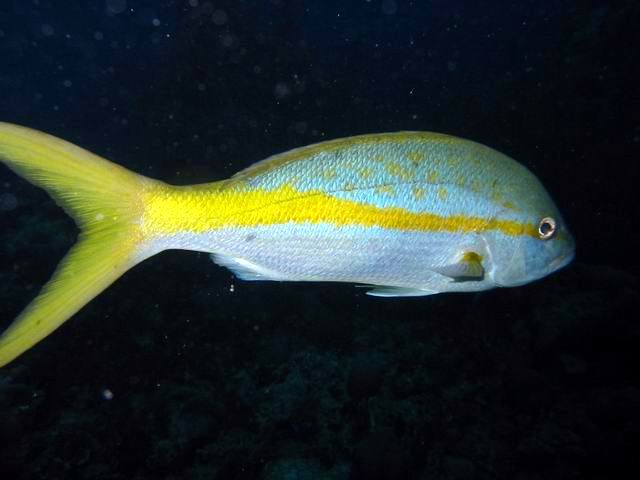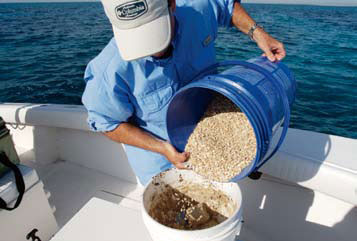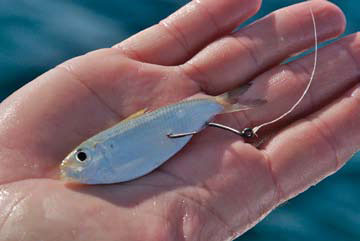Why We Love Boating
Years ago while cruising in
the Caribbean we dangled a couple of lines over the side at sundown. To our delight
we happened into a school of yellow tail snapper and in a few minutes we have half
a dozen aboard. In a flash they were dressed, grilled, and served to a hungry group
of kids that didn’t like fish – until then! Fresh yellow tail snapper are so delicious,
even kids love them. It was a meal we will always remember.

|
In case you haven’t guessed, this is a yellow tail snapper, perhaps the best tasting fish you’ll ever catch. |
Home sweet home: It’s no secret. Yellowtail, like most if not all
other snapper species, are structure huggers. They are not open-water fish and will
NEVER be found roaming far from the security of some sort of jagged debris field.
Favored habitats include coral reef, rocky outcroppings and sharp, cliffy ledges
with distinct drop-offs. Deteriorated wreckage and dilapidated, submerged towers
are also favorite haunts. Common depth is 30- to 130-feet and everywhere in-between,
with the largest specimens found in the deeper echelons. Depending on conditions,
drift fishing or anchoring over the aforementioned promising areas are both feasible
options, with the latter most effective after locating a concentrated area of fish.
Net results: Once structure is located and you have positioned
yourself in an optimum position just up-current of the targeted real estate, the
most popular method of attracting yellowtail snapper to within easy casting range
is with the means of frozen block chum. Though this approach is fairly cut and dry,
many reef fishermen still make the mistake of utilizing those inexpensive white
chum bags found bait & tackle retailers across the state. Sure they work, but
their tiny ¼” holes restrict the juiciest morsels from entering your chum slick.
It’s these large tidbits that get trapped in the bottom of the chum bag that keep
large yellowtail interested. You may not know it, but these fish have a voracious
appetite. Rather, configure discarded landing net material into a chum bag. Yes,
with substantially larger holes you will go through a much greater amount of chum,
but you will also attract a much greater array of life, and isn’t that idea? Serious
‘tailers aren’t afraid to go through 20 blocks of chum in a single outing.
Sand in your hand: An approach rarely employed by anyone other
than Florida Keys charter crews, sand-balling is an extremely effective means of
creating your own version of a feeding frenzy. Ingredients vary, but a mixture of
thawed chum, oats and typical beach sand will do the trick. Mix thoroughly before
forming the mushy mess into tennis ball size handfuls. Deploy sand-balls at even
intervals dependant on the speed of the current. As the sand-ball deteriorates on
the way toward the bottom, it disperses an irresistible scent of oil, shimmering
scales and tasty tidbits throughout the entire water column. The sand also clouds
the water which helps entice strikes from line shy fish.

|
Go with the flow: Moving water is a must in order to disperse your
chum over a great distance and attract fish from much farther away then only directly
under the boat. If there is no current in the area you intend to fish, you have
two options. Wait it out or relocate. Often, an hour of time or a shift of only
20 or 30 feet in depth can have a dramatic effect on the overall outcome of your
trip.
Live bait bites: Once your chum slick and/or sand-balls have effectively
attracted the attention you’re looking for, freshly cut chunks and strips of assorted
baitfish work extremely well as hook baits. Shrimp, squid, even tiny crabs will
seldom go ignored when in the company of hungry yellowtail. However, no other bait
grabs and holds the attention of these feisty and sometimes picky reef rockets like
juvenile pilchards. The small live baits also have the effect of deterring undersize
fish from attacking your offerings.

|
Lighten up: When all else fails, lighten up! Like with so many
other species, yellowtail snapper can, in fact, be line shy. If you have made visual
contact and are confident your targeted species is in the vicinity but are simply
ignoring your offerings, drop down in terminal tackle. Lighten up on the weight,
tie on a smaller hook, and drop down in leader strength until you begin experiencing
strikes on a regular basis. The best of the best often fish as light as 8 lb. leader
for shy ‘tails.
Get jiggy with it: While freelined baits are hard to beat, when
conditions require a deeper presentation, a 1/16, 1/8, or ¼ oz. jig-head tied directly
to your line is an excellent alternative. The added weight will assist in presenting
your morsel deeper in the water column where the yellowtail may be feeding. Both
live baits and freshly cut strips can effectively be fished on jig-heads.

|
Bottom bonuses: Grouper, typically blacks and gags, prefer the
same sort of structure and are also among the hungry visitors to yellowtail feeding
frenzies. But unlike the frisky ‘tails which readily snatch just about anything
you freeline into the chum slick, grouper prefer full course meals served directly
on the bottom. Deploy a large live baitfish or small, legal-size yellowtail on a
stout conventional outfit with enough lead to keep the bait in the strike zone on
or near the bottom, and you could wind up with a beautiful bonus.

|
Reprinted from Florida Sport Fishing Magazine.